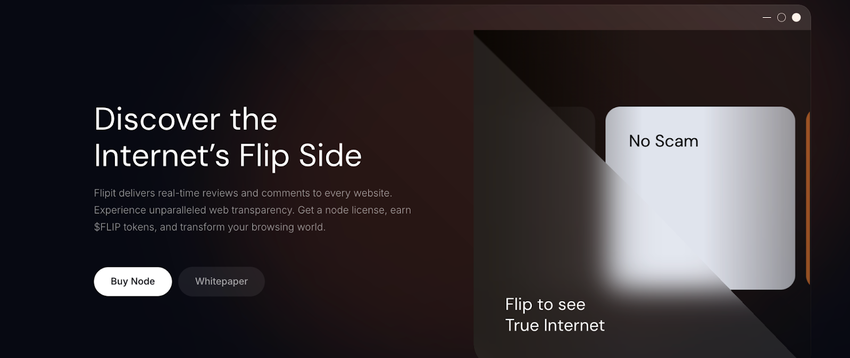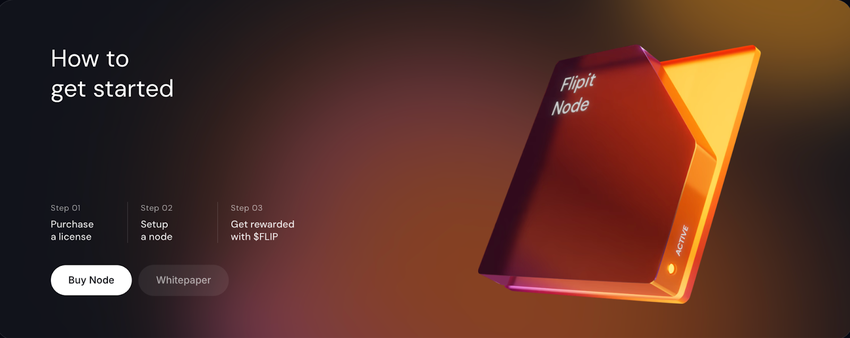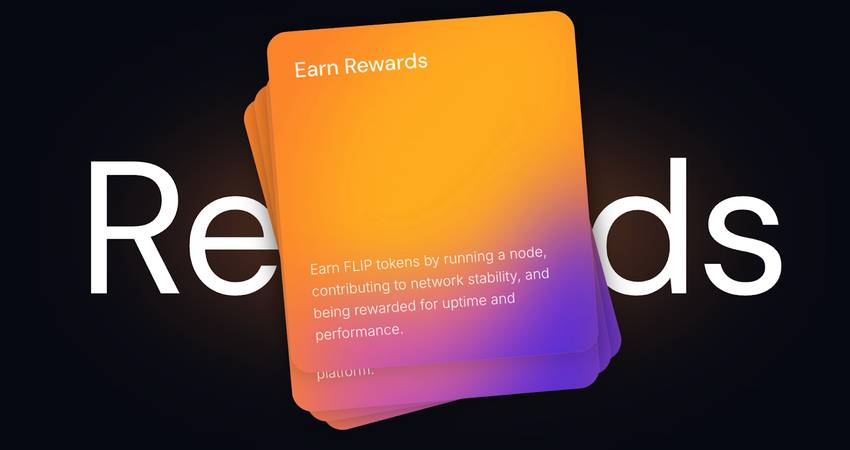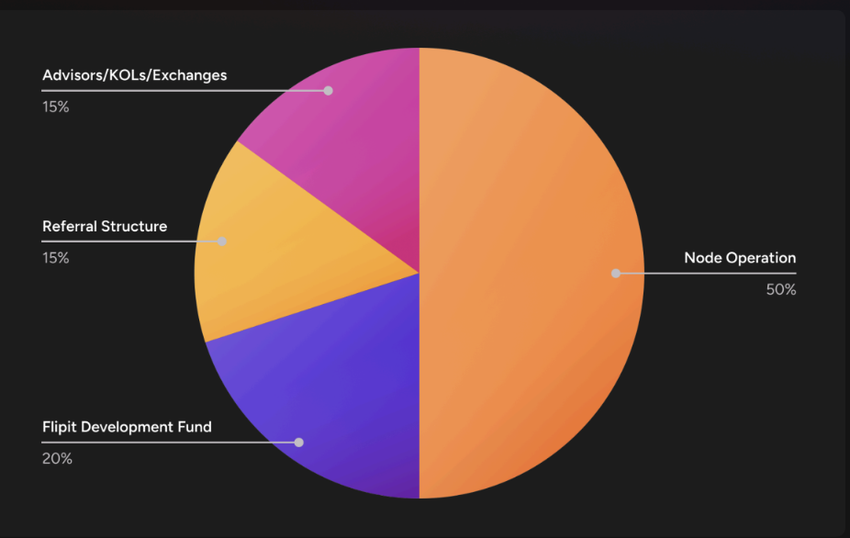Fake reviews and hidden agendas thrive beneath the polished veneers of today’s internet. The web3 platform Flipit looks to rewrite this narrative and empower users through honest online interactions. It does so by revealing a hidden layer behind every web page, an element we will explore in detail in this comprehensive Flipit guide. Here’s everything you need to know about the transparency-geared platform in 2025.
KEY TAKEAWAYS
➤ Flipit supports user transparency by offering an extra layer of verified content behind any webpage.
➤ The project runs on a decentralized node network, ensuring that the content users generate is secure and tamper-proof.
➤ The Flipit node sale is ongoing. Nodes started at $500. As of late October 2024, nodes are priced at $1000, following a rapid sell-out of the first five pre-sale tiers.
What is Flipit?
Flipit allows users to share reviews and opinions on the “back” of any webpage. The platform supports an additional layer of transparent content that website owners don’t control. By unearthing a hidden layer behind every webpage, Flipit helps users engage with user-verified, transparent content.

Think of the internet as a showroom — everything looks perfect on the surface. With Flipit, it’s like being handed a backstage pass, where you get to see the raw, unfiltered reality behind each webpage (showroom components).
No more relying on biased reviews — Flipit gives you the power to interact with and contribute to a more honest online space.
Who is behind Flipit?
Flipit is partnered with LFG Inc. (Let’s Fight Giants), a blockchain development entity developed by former Gala Games execs. Helming LFG is Jason “BitBender” Brink, who is also the President of Blockchain at Flipit.

Did you know? Jason Brink was also the former President of Blockchain at Gala. He, along with other former Gala executives, collectively ensures LFG’s adherence to its mission of improving web transparency.
Flipit’s founder and CEO, Mike Helm, held previous leadership roles at DittoTalk and Evernet. Helm runs Flipit with the specific aim of curbing internet-specific corruption.
With LFG’s guidance and infrastructure, Flipit maintains control of its own development and direction, focusing on empowering users to share real, unfiltered content on the “back” of any webpage.
How does Flipit work?
So, how does Flipit manage to access real discussions and reviews and assist with content validation? In short, the platform implements content moderation strategies and smart filtering to offer credible content.

Here are a few of the elements at play:
Visual Curl
Flipit’s “Visual Curl” technology allows users to “flip” the webpage as if peeling back a layer of information.
Think of Flipit’s Visual Curl technology as a way of using sticky notes on a book. When you’re reading a page, you get the author’s polished version of the story. But what if you could flip to the back of that page and see sticky notes left by other readers? This is an analog representation of Flipit’s digital ability.
Bot moderation and credibility system
Flipit powers through the spread of spam and misinformation using its Credibility (Cred) system. Users are scored based on the quality of their contributions, and genuine, meaningful input is rewarded. This system also uses advanced bot detection tools to weed out false reviews or automated content.
Live chat
As an interaction platform at heart, Flipit integrates live chat functionality right into the back layers of web pages. This way, users can engage in real time without having to wait for responses when making an important decision.
This implementation is akin to flipping over a page of a magazine and finding a community of people discussing the article right there, in real time.
Node support
This is where things get interesting. Flipit runs on a decentralized node network, ensuring that the data and content users generate are secure, transparent, and tamper-proof.
These nodes distribute data processing and storage, making the platform resistant to censorship or control by any single entity. Let’s examine the concept of nodes in relation to Flipit in a little more depth.
What is a Flipit node?
A Flipit node is a decentralized server that helps store, process, and verify the content on the Flipit platform. By running a node, users contribute to maintaining the network. This ensures that data can be stored securely across a distributed system rather than controlled by a central server.
It is worth noting that nodes participate in content governance, ensuring the voting mechanism holds for platform-specific changes and improvements.
Think of a Flipit node as a mini-data center run by individual users. These users (node operators) help Flipit run smoothly by hosting parts of the platform’s data and participating in decision-making processes.
Every time a user flips a webpage, the data they access (such as reviews or discussions) is supported by a network of decentralized nodes, ensuring transparency and security.
As with any data center, running the Flipit nodes comes with specific hardware requirements. For instance, the machine you want to run the node on must at least have the following specs:
- CPU: 2 cores
- RAM: 4 GB
- Storage: 60 GB
- Operating system: Windows, Mac, or Linux (64-bit)
- Stable internet connection: Nodes require a reliable internet connection to process and distribute data efficiently.
Flipit nodes function with the help of the following traits:
Usage of InterPlanetary File System (IPFS): This decentralized storage system allows data to be stored and accessed across multiple computers (nodes) in a distributed way rather than being stored on a single server. Flipit nodes use IPFS to store and distribute data.
Governance: Node operators also play a role in Flipit’s governance. They can vote on important platform decisions, helping shape the company’s future.
Credibility & content verification: Each node helps verify the content’s authenticity, ensuring that what users see on the back layers of webpages is genuine and community-approved.
Personalized feeds
Flipit also tailors the back layer of content to users’ interests by utilizing a personalization feed. Based on your browsing history and interactions, the platform curates relevant content, showing you discussions and reviews that align with your preferences.
What about Flipit’s technical implementations?
Here is a quick breakdown of how Flipit works behind the scenes:
- Implementation of blockchain technology
- Smart contracts incentivize constructive commenting by rewarding users with tokens.
- Flipit uses a network of nodes to distribute processing and storage.
- In case of any node failure, the network continues to function by redistributing tasks to other nodes.
How can you get a Flipit node?
If you want to own a Flipit node, here are some things to consider.
The price of Flipit nodes started at an early bird presale price of $500. As of late October, you can buy nodes at the Tier 6 price point of $1000. Keep in mind that as more nodes are sold, the price increases by $100 for every 100 nodes, with a cap of $10,000. So, the sooner you purchase, the better the deal.
You can verify your Flipit Node License by using blockchain explorers like Etherscan.io or by checking platforms like OpenSea.io, where the token will appear in your wallet.

It is worth mentioning that Flipit node permissions are ERC-1155 tokens, which are added to your wallet. Tokens here represent ownership and cannot be transferred for the first 90 days post-purchase.
Key features of Flipit
Flipit is more than a platform for flipping through web pages. Here are some of the other features you should know about.
- Flipit adds an interactive back layer to every webpage. Users can engage with hidden content such as reviews, discussions, and additional media without relying on the webpage owner’s input.
- Flipit offers a reputation system that tracks and rewards users for honest interactions.
- For advertisers, there is a unique opportunity to place highly targeted advertisements on the back layer of specific web pages. For example, an ad for a tech product can appear on the back layer of a competitor’s website, reaching users at relevant moments and increasing ad impact.
- Flipit’s nodes, which are integral to its decentralized architecture, have unique perks — including exclusive premium content, participation in governance decisions, and the ability to earn FLIP tokens.
- Users can unlock premium content by using FLIP tokens. This content includes exclusive articles, videos, and media that would otherwise be unavailable on the standard webpage.

Besides the mentioned features, Flipit offers community-driven credibility, IPFS-driven decentralized data storage, live chats, a credibility verification system, a bot-weeding arrangement, and more.
Flipit tokenomics
The FLIP token lies at the heart of the Flipit ecosystem. It powers various aspects of the platform, from node rewards to content moderation and governance participation.
As for the tokenomics, FLIP has an initial supply of 100 million tokens, 50% of which are allocated for the node operations. This significant allocation ensures nodes remain incentivized to contribute to the platform’s stability and content hosting.
15% of the tokens are set aside for the referral program. This incentive encourages users to refer new participants.
Another 15 million tokens are allocated to key opinion leaders (KOLs), advisors, and exchanges. These stakeholders are essential for promoting the platform, building strategic partnerships, and maintaining liquidity within the ecosystem.
And finally, 20% of the tokens have been earmarked for feature additions and future upgrades.

Did you know? Flipit employs a token-burning mechanism whereby a portion of tokens used in transactions (e.g., for premium content or ads) is permanently removed from the circulating supply. This deflationary approach helps maintain the value of FLIP tokens by reducing the total supply over time, especially as platform activity grows.
The utility of FLIP
Besides the deflationary model, the FLIP token also comes with a host of utilities. These include:
- Access to premium content
- Highlighting contributions
- Access to voting rights
- A payment method for targeted ads
- Rewards for node operators
- Referral incentives

Flipit’s roadmap
Some of the mission-critical future features the project has planned include:
- New design enhancements
- An overhaul of the front end using Vue 3 to improve performance and scalability.
- Major redesign of the Tab+ feature
- Further integration of the Cred system to enhance user credibility and trustworthiness on the platform.
- Introduction of advanced analytics tools
Flipit vs. competitors
Current user interaction-focused platforms include big names such as X, Facebook, Lens (a decentralized option), and more.
Unlike centralized platforms, where user control is limited, or decentralized platforms with smaller user bases, Flipit supports a balanced model of community-driven moderation, credibility ratings, and decentralized storage.
Is Flipit the future of online content consumption?
Flipit redefines how users engage with online content. Through its unique back-layer approach, the project offers transparency and user-driven interactions. Of course, there are no guarantees of a project’s longevity. Yet by decentralizing content and rewarding participation, Flipit has positioned itself as a possible game-changer in the future of web consumption.
Disclaimer: This article is for informational purposes only and should not be considered investment advice. Neither buying a node nor investing in the FLIP token guarantees profit.

